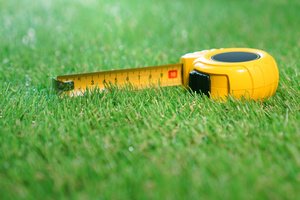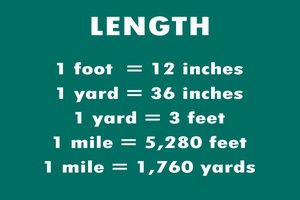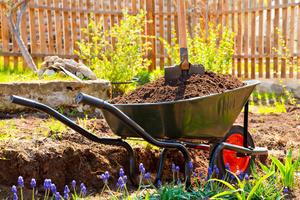Ordering the right amount of soil or fill dirt for home and gardening projects can be challenging because it often involves units of measurement that many people are unfamiliar with. Here is a look at common soil measurements and the conversions you may need to determine how much soil to order for your project.
Understanding Common Soil Units of Measurement

The most common unit of measurement you will encounter when working with soil is cubic yards. This is a unit of volume, which means it is three-dimensional. Cubic yards are used when you need to fill a hole in the ground with soil, gravel, mulch or another type of material. To visualize a cubic yard, imagine an empty cube whose sides are one yard each. When this empty cube is filled to the top with soil, you will have a cubic yard of soil.
Most tape measures use inches and feet, so you will need to understand how to make the necessary conversions:
1 cubic foot = 12 inches x 12 inches x 12 inches
1 cubic yard = 27 cubic feet or 46,656 cubic inches
Measuring and Calculating Soil
First, you will need to know the dimensions of the space that you plan to fill. This will require careful measurements of the space’s width, length and depth. Measure twice to ensure accuracy-asking someone for help if it is a larger space. You may wish to use a measuring wheel rather than a measuring tape for greater accuracy in bigger spaces.
Be sure to write down the measurements – working from memory is not recommended as other figures will enter into the calculations and could cause confusion.
There are two main ways that you can calculate the amount of dirt you will need ahead of a project: converting feet to yards either at the end of the calculation or at the beginning.
Converting to Yards Last
To determine the amount of topsoil needed for a flower bed measuring 6 inches deep, 12 feet long, and 12 feet wide, you’ll first need to convert the depth dimension from inches to feet so you can work with three dimensions of the same unit. This is simply a matter of dividing by 12, the number of inches in a foot.
6 inches (depth) ÷ 12 inches in a foot = 0.5 feet
Then, you should multiply the dimensions of the flower bed together to determine the number of cubic feet needed.
0.5 feet (depth) x 12 feet (length) x 12 feet (width) = 72 cubic feet
Next, to find the number of cubic yards this represents, you need to divide your cubic feet by the number of cubic feet in a yard, which, as discussed previously, is 27.
72 cubic feet ÷ 27 cubic feet in a yard = 2.67 cubic yards.
This means you will need to order 2.67 cubic yards of dirt to fill your flower bed.
Converting to Yards First

However, like many mathematical operations, there is more than one way to make this calculation. You can convert the dimensions of your flower bed to yards in the first step rather than at the end.
Begin by converting the dimensions from inches – which, in our example, is the depth of 6 inches – to yards.
6 inches ÷ 36 inches in a yard = 0.167 yards
Then, convert the dimensions from feet – in our example, the length and width of the flower bed, which are both 12 feet – into yards.
12 feet ÷ 3 feet in a yard = 4 yards
Finally, you’ll need to multiply the three dimensions together to calculate the number of cubic yards needed.
0.167 yards (depth) x 4 yards (length) x 4 yards (width) = 2.67 cubic yards
Measuring a Circular Area
If you need to fill a circular area, you will want to measure the diameter of the space as well as its depth.
Let’s say the diameter, or the measurement across the circle, is 60 inches. You’ll need to know the diameter to determine the radius, which is half the diameter. This means the radius in our example is 30 inches.
Then, let’s say the depth of the hole is 30 inches.
Now, we can calculate the area of the hole you need to fill.
You’ll need to use the standard formula for calculating the area of a circle, which is πr2h, where π is a constant that equals 3.14, r represents the radius of your circle, and h is its height or depth.
3.14 x (30 inches)2 x 30 inches = 84,780 cubic inches
Finally, we must convert this to cubic yards by dividing it by the number of cubic inches in a cubic yard, 46,656.
84,780 ÷ 46,656 = 1.82 cubic yards
Cubic Yard Coverage
One cubic yard, or 27 cubic feet, is enough soil to cover the following space:

- 300 square feet at 1 inch deep
- 150 square feet at 2 inches deep
- 100 square feet at 3 inches deep
- 75 square feet at 4 inches deep
- 62 square feet at 5 inches deep
- 50 square feet at 6 inches deep
Keep in mind that these are just general guidelines; the specific amount will depend on the type of soil and the amount of moisture it is holding.
Although these calculations may seem complicated, it is essential to understand how much soil you need for various projects to avoid falling short or purchasing more than you need, particularly if you are having it delivered to your home.
However, it is advisable to order slightly more soil than you think you will need. Round up to make sure you have enough material to complete your project. If you have determined you will need 2.7 cubic yards, for example, order 3 cubic yards to avoid running out.
If you need to fill a space with an irregular shape, you can leave the calculations up to your dirt supplier, who will assess the area and calculate its volume on your behalf. They can also determine the amount of soil you need based on measurements you provide them. In addition, there are calculators available online that can help with these conversions.
Contact the Soil Professionals at Dirt Connections
If you need help calculating the right amount of soil for your project or would like to arrange a delivery of fill dirt in the Northern Virginia area, reach out to the professionals at Dirt Connections today.
Summary

Dirt Connections was started with one goal in mind: providing quality residential and commercial construction services to clients on time and on budget. Reach out for more information on how we can support your next project.
For your convenience our estimates are free and by appointment. Call 703-940-9949 for a free estimate today!









































